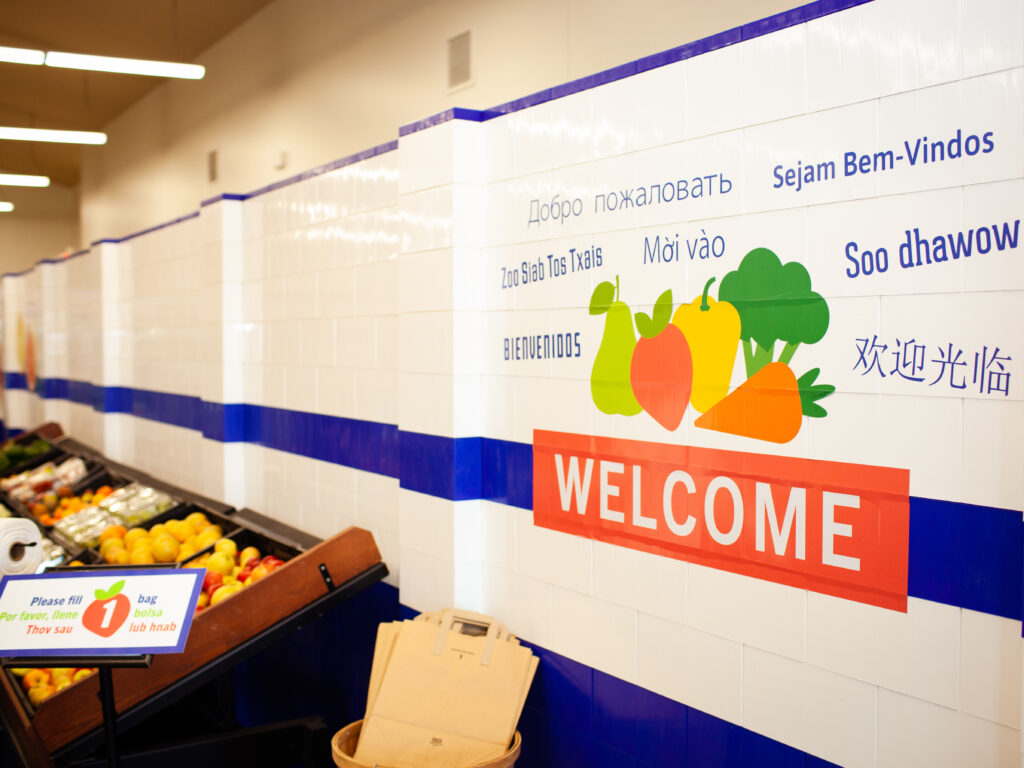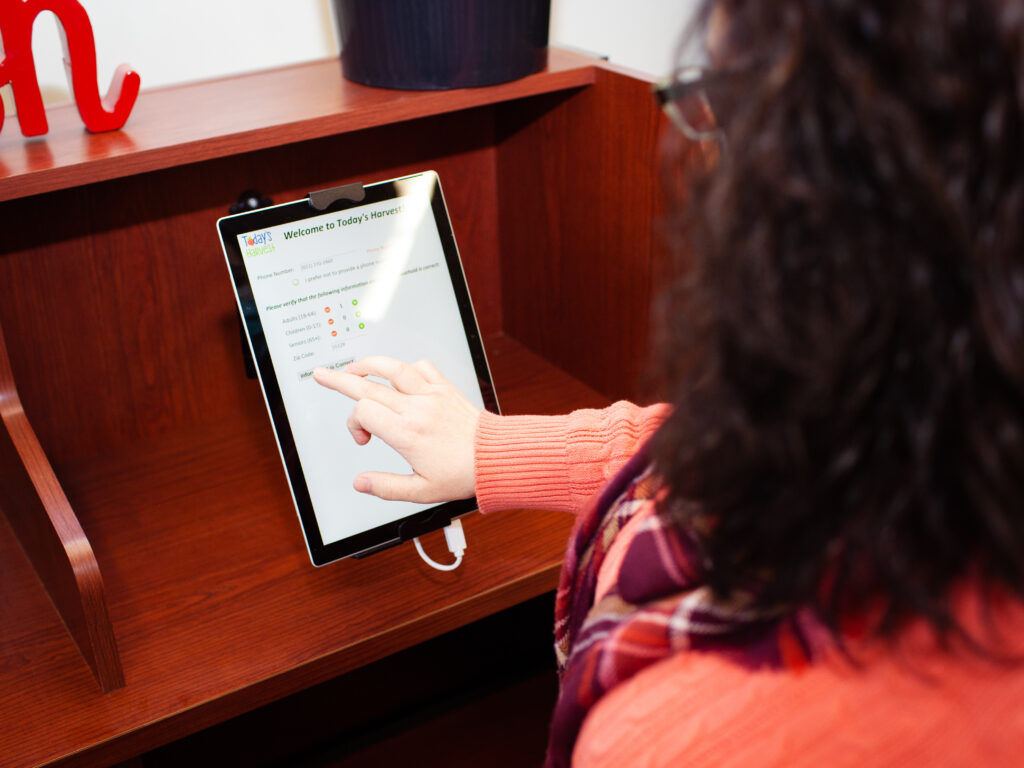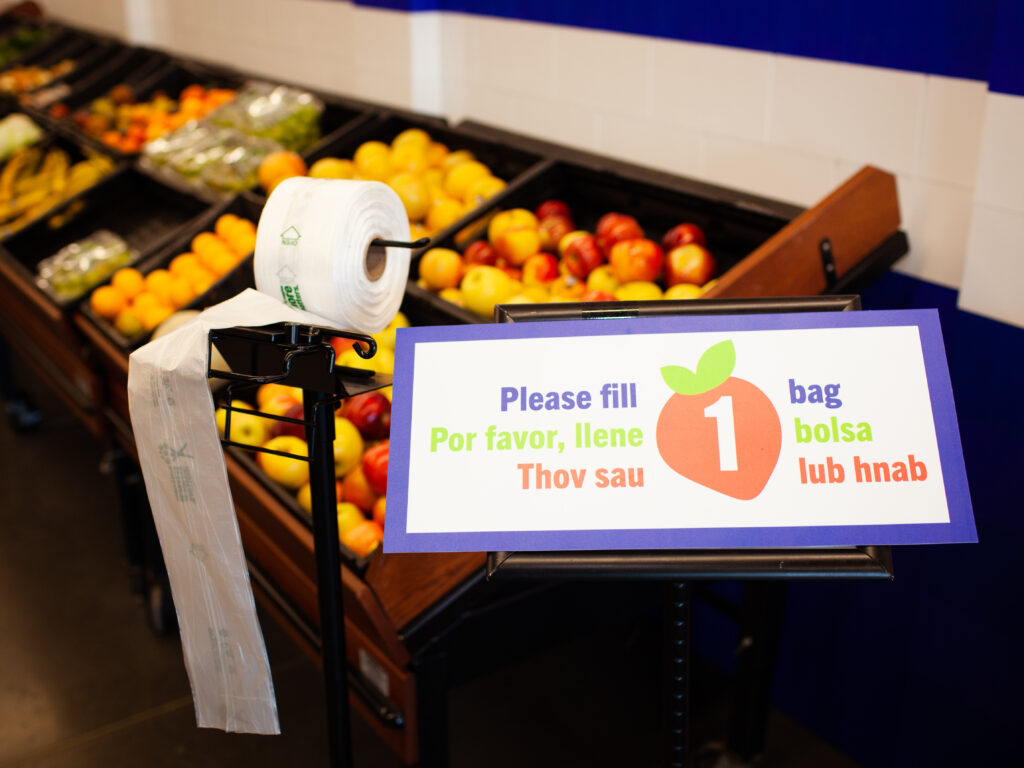Today’s Harvest may look much like any other bright, friendly neighborhood market, but it’s so much more.

Six days a week Today’s Harvest shoppers grab a cart and select from a variety of fresh fruits and vegetables, baked goods, meats, dairy products, and more in a colorful, welcoming store. But this store doesn’t take cash or credit cards — or any payment at all. The no-pay market is stocked with food rescued from local grocery stores, farms, and other partners. Most is close to expiring, but still safe to eat. And the customers are primarily families who are food insecure.
“Accessibility doesn’t sound that revolutionary, but it changes the experience when anybody can shop without having to go through gates or barriers.”
— Jessica Francis, Executive Director
Today’s Harvest is a program of Open Cupboard, formerly known as the Christian Cupboard Emergency Food Shelf (CCEFS). When Executive Director Jessica Francis came on board in 2019, she was the only full-time staff member. Today there are 12 employees, 11 board members, two store locations, and 700 to 800 committed volunteers at the heartbeat of this operation.
“Things moved fast when we decided to grow – we went from the idea to the opening of our first market within 100 days,” said Francis. “At the end of 2020 and beginning of 2021 we had some unspent donations. Our board didn’t want the funds to just sit in a bank account when our community really needed us. So we asked ourselves, ‘How can we use these donations to do more?'”
The answer came from a suggestion made earlier by one of the organization’s key volunteers, Sue Gillman. “Before the pandemic started, she had visited Australia,” explained Francis. “She saw a similar market there and decided to volunteer while on vacation. That’s the kind of volunteers we have here — they volunteer while they’re on vacation.” Off and on, Francis and her team talked about the model: a simple, easy place where people could just pick out fresh items every day. When the board issued their challenge, the idea clicked into place.

The first Today’s Harvest market opened in May of 2021. Customers immediately responded to the choice, convenience, and accessibility model of the market. In its first year, the Today’s Harvest market welcomed more than 53,000 shoppers, served over 7,000 unique households, distributed more than 800,000 pounds of food, and averaged 535 first-time shoppers per month.
Open Cupboard has operated as a traditional food shelf since 1983, distributing free food, household items, personal hygiene products, pet food, and more through their drive-up and delivery services. Those services are still available, but the markets provide something different.
“I think so many people are coming because of the way it feels,” said Francis. “Accessibility doesn’t sound that revolutionary, but it totally changes the experience when anybody can shop without having to go through any gates or barriers. Everybody who walks in knows that they’re going to get food that day. We don’t ask if they’re eligible or if they live in the city. It’s a significant difference.”
Once the first market proved successful, Francis and the board began discussing how to expand. They turned to Creation in Common to help guide them strategically through the conversation. Hunger Solutions provided the funding for a scaling feasibility assessment. The results of the study, conducted by Creation in Common, served as a guidepost.

“When we began the discussions, we weren’t all on the same page,” Francis reflected. “Creation in Common’s work gave us a common base of knowledge and information.” Francis and her board decided to focus on building strategic partnerships that would allow them to do two things in the short term: open a second market and develop a toolkit for others interested in the Today’s Harvest model.
The team opened the second market in March 2022 in the same location as Open Cupboard’s existing food distribution program. Hundreds of thousands of pounds of food and more than 400 shoppers move in and out of the site every day. Within its first 3 months the market had welcomed nearly 21,000 shoppers, served over 5,200 unique households, and distributed more than 350,000 pounds of food. Francis calls it a “careful dance” to juggle the workings of several programs on one site.
The upside is the flexibility it provides families. Francis explained, “If someone is hesitant to use a food shelf, but is drawn to us because they heard about the market, we can let them know that in the same location they can get cat and dog food and diapers and shampoo. In one place, they can pick out specialty items in the market then use our Drive Up service and stock up on core basic needs. The presence of the market helps some people feel more comfortable visiting our traditional food shelf, if they need more help.”
Operating six days a week in two locations has required more volunteers. Some volunteers put in as many as 10 to 20 hours per week. Francis, who has worked her whole career in nonprofits, says she has never seen anything like it. The team works with Community Thread, the volunteer resource center for Washington County, and welcomes groups of corporate volunteers. But recruiting volunteers is an ongoing effort — they can always use more.
The other key to Today’s Harvest’s success is its partners. Second Harvest, the organization’s biggest food provider, also funded a large grant to help open the second market. Hunger Solutions granted the funds that paid for Creation in Common’s feasibility work and the creation of the toolkit that helps explain the model.
Other food providers range from grocery stores, church community gardens, and farmers who drop off whatever they don’t sell at local farmers’ markets, to Lions Club volunteers who rescue food from KwikTrip and culturally specific grocery stores, like United Noodles.
Open Cupboard is exploring possible expansion to open additional markets, whether on their own or partnering with another agency to operate them. Francis would love to see similar markets open across the state and around the country. The toolkit she and her team developed offers communities a model for opening their own version of Today’s Harvest.
“While the Today’s Harvest brand is specific to our organization, the toolkit gives people information about the general model” noted Francis, “How many volunteers does it take? Why is it important that you merchandise like a store? We’re hoping the toolkit can help bring innovation to our sector. Maybe other organizations will read about what we’re learning and then make some adjustments to their programs. I hope our work can initiate some valuable little ripple effects throughout our entire sector.”





 Follow @cmcuesta
Follow @cmcuesta